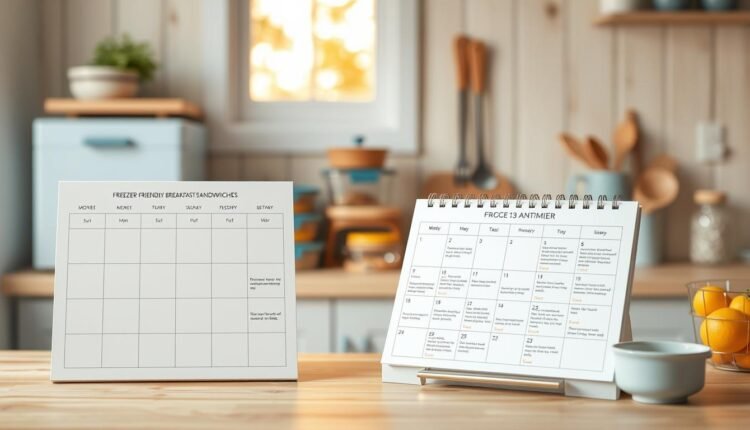Freezer Breakfast Sandwiches Meal Planning Monthly Calendar
Master freezer breakfast sandwiches meal planning with our step-by-step guide. Learn how to prep delicious breakfasts in advance for busy mornings.
What if your mornings could start with calm instead of chaos? I’ve spent years helping busy households streamline their routines, and one strategy consistently stands out: a monthly roadmap for morning fuel. Picture golden-brown english muffins stacked with fluffy baked eggs, all prepped in one afternoon and ready to grab whenever life gets loud.
My own kitchen journey taught me that success lies in mixing smart systems with real-life flexibility. By batch-cooking core ingredients (like oven-roasted veggies or protein-packed egg sheets) and pairing them with quality bases, you’ll create a rotation of satisfying options. The secret? A simple calendar that aligns with your schedule—no culinary perfection required.
Key Takeaways
- Transform hectic mornings with a 30-day roadmap for grab-and-go fuel
- Master batch-cooking techniques for oven-baked efficiency
- Build better sandwiches using flavor-packed recipes and smart prep
Through trial and error—plus feedback from readers like you—I’ve refined methods that work for gluten-free diets, picky eaters, and tight budgets. Let’s explore how a little upfront effort can turn your freezer into a breakfast ally, one delicious layer at a time.
Introduction to Freezer Breakfast Sandwiches Meal Planning
Mornings don’t have to mean chaos or cold cereal. Imagine opening your kitchen to a lineup of ready-to-reheat handhelds that actually taste fresh. This approach combines smart prep with smart ingredients—think golden-brown english muffins hugging fluffy egg patties and savory bacon strips. It’s not magic, just clever planning.
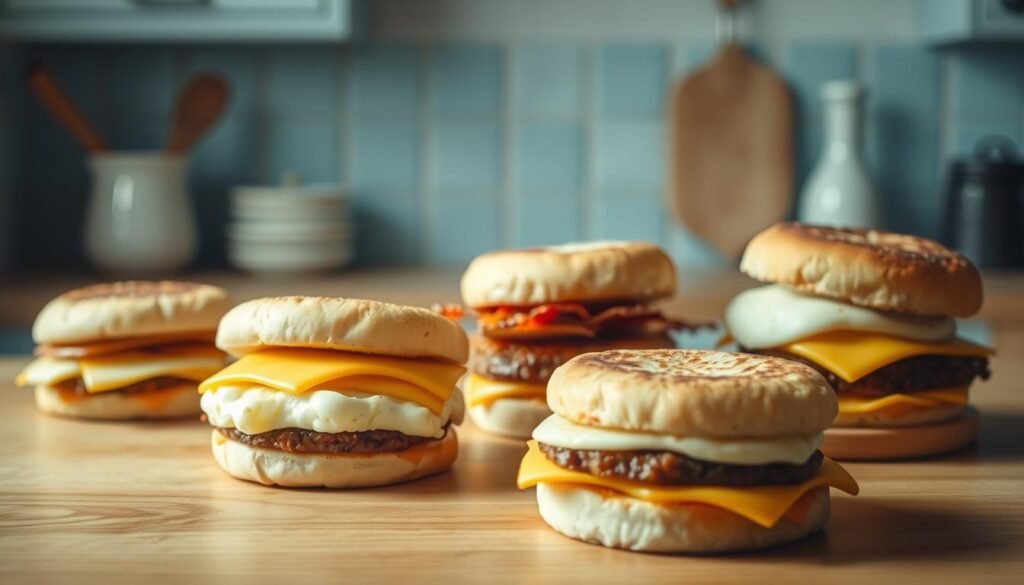
Your New Morning Game Plan
Busy households thrive on systems that work when life doesn’t. Pre-assembled handhelds eliminate the “what’s for breakfast” scramble. One Sunday session can stock your cold storage with 15-20 satisfying options. I’ve found crispy bacon holds up better than sausage during reheating, while oven-baked eggs stay tender—key details that make grab-and-go meals feel special.
Why This Works Better
The secret lies in ingredient synergy. English muffins outperform bagels or toast by maintaining texture after freezing. For those exploring gluten-free options, I recommend toasting them lightly before assembly. Batch-cooked components ensure every bite matches your effort—no sad, soggy bread or rubbery eggs here.
This method isn’t about perfection. It’s about creating a safety net for hectic days. With components pre-portioned, you’ll spend less time deciding and more time enjoying that first sip of coffee.
Essential Tools, Ingredients, and Prep Techniques
Ever opened your fridge to find mismatched ingredients and dull knives? Let’s fix that. Smart tools and intentional components transform rushed mornings into streamlined sessions. I learned this after burning my third batch of eggs using the wrong pan—now I stick to these essentials.
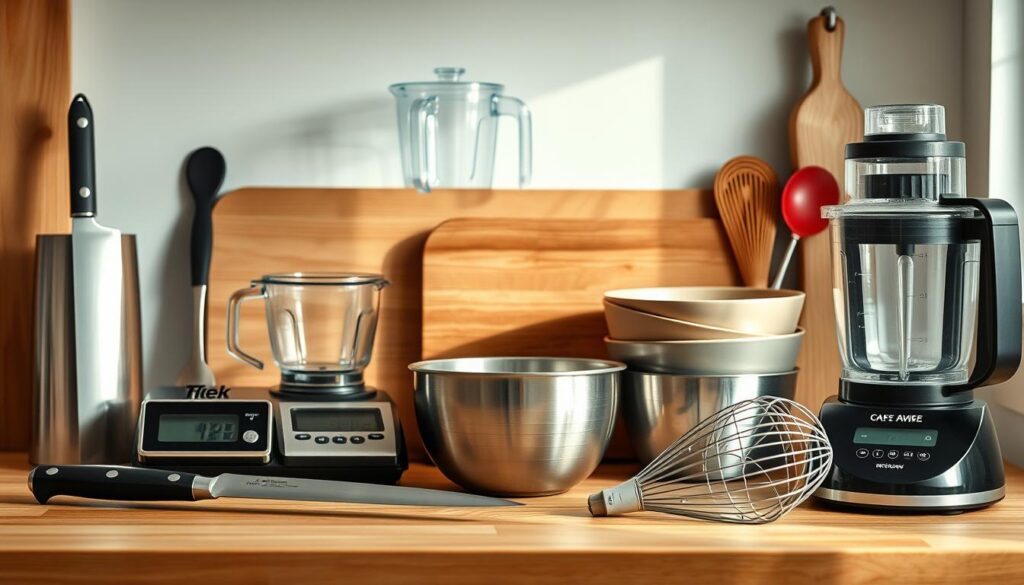
Equipment That Earns Its Cabinet Space
Start with a 9×13 baking pan—its edges prevent spills and promote even cooking. A sturdy mixing bowl with a spout makes pouring egg mixtures mess-free. Keep these within reach:
- Non-stick skillet (for crispy bacon)
- Biscuit cutter (creates uniform egg rounds)
- Digital scale (precision beats guesswork)
Ingredients That Pull Their Weight
Fresh eggs are non-negotiable—their proteins set better during baking. For every 6 eggs, I whisk in 2 tablespoons of whole milk using a teaspoon-measured dash of salt. Quality oil matters: avocado oil handles high heat, while olive oil adds flavor to roasted veggies.
“Your muffins deserve better than floppy eggs. Precise heat control turns basic ingredients into crave-worthy layers.”
Cheese acts as a moisture barrier—sharp cheddar outperforms mild varieties. If you’re adapting my make-ahead breakfast sandwich recipe, note that slightly undercooking eggs prevents rubberiness during reheating. Measure flour-dusted surfaces with a ¼ cup scoop for consistent muffin sizing.
Arrange your station before cracking eggs: bowls left, pans center, cooling racks right. This workflow prevents cross-contamination and keeps your countertop chaos-free. Now let’s transform these components into your new morning routine.
Effective Strategies for Freezer Breakfast Sandwiches Meal Planning
How many mornings have you lost to indecision and last-minute scrambling? A structured calendar turns kitchen guesswork into grab-and-go confidence. I learned this after burning through three batches of overcooked eggs—now I stick to this battle-tested system.
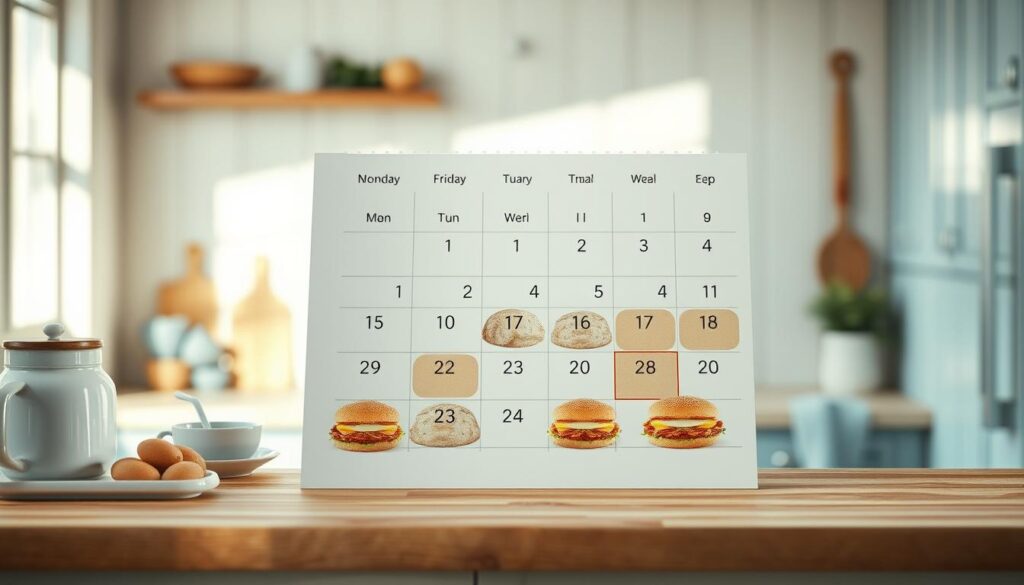
Blueprint for Success
Start with your sheet pan. This unsung hero ensures consistent results when baking multiple egg rounds. Here’s what works best:
| Oven Temp | Bake Time | Egg Texture | Cheese Melt |
|---|---|---|---|
| 350°F | 15-17 mins | Fluffy | Partial |
| 375°F | 12-14 mins | Firm | Full |
| 400°F | 10 mins | Crispy Edges | Browned |
Always preheat oven properly—it’s the difference between rubbery and tender eggs. For easy assembly, slice cheese uniformly using dental floss (yes, really!). This creates clean layers that melt evenly during reheating.
Build your cold storage workflow around prep days. Batch-cook components every other Sunday, storing them in labeled containers. Leave one “flex” week monthly for using leftover veggies or proteins. Your future self will thank you when Wednesday’s alarm rings.
“The right oven minutes transform basic ingredients into gold. Treat your baking sheet like a canvas—layer flavors strategically.”
Adjust oven minutes based on your appliance’s quirks. My old gas range needed +2 minutes compared to my current convection model. Track what works in your kitchen, then pencil it into your calendar for repeat success.
Mastering the Baking and Assembly Process
Ever pulled a pan from the oven only to find uneven edges or undercooked centers? Precision matters when building handhelds that reheat like they’re fresh. Let’s break down the art of crafting layers that hold their texture and flavor through freezing.
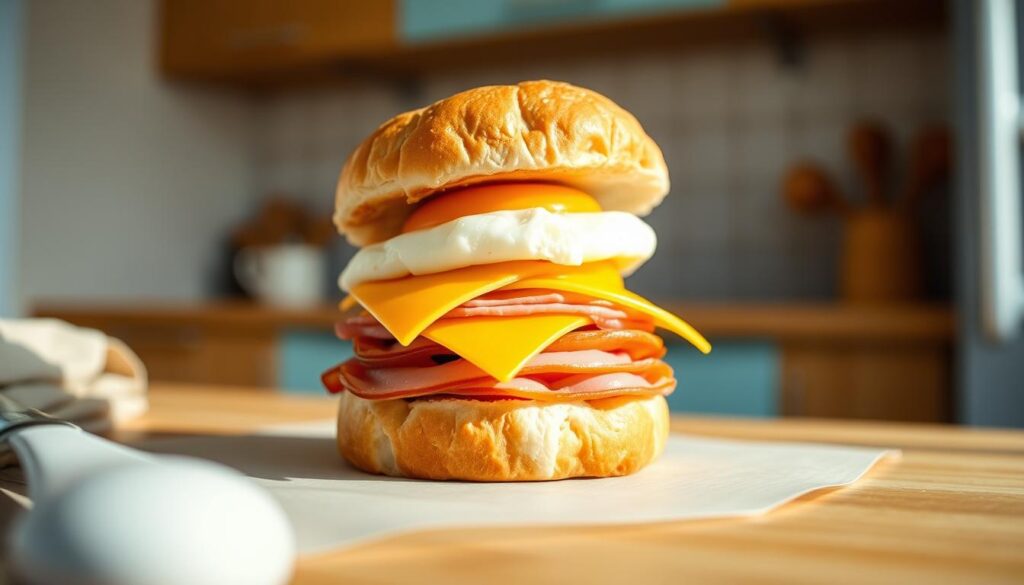
Eggcellence Starts Here
Whisk 8 eggs with ¼ cup milk until smooth—no streaks. Pour into a parchment-lined sheet pan for easy cleanup. Bake at 375°F for 12 minutes to create golden sheets that slice into perfect squares. Pro tip: Let eggs cool slightly before pressing a biscuit cutter through them. This prevents tearing and ensures uniform layers.
- Use room-temperature eggs for even cooking
- Rotate pan halfway through baking
- Mark portion lines with a knife before cutting
Stack Like a Pro
Start with toasted muffin bases—their crunch withstands reheating better than untoasted ones. Layer cooked sausage patties (they stay juicier than bacon), then add egg squares. Top with sharp cheddar slices that melt into nooks without overwhelming other flavors.
“Your hands are the best quality control tool. If it feels unbalanced when cold, it’ll be worse after microwaving.”
For variety, try these swaps:
| Protein | Prep Style | Reheat Result |
|---|---|---|
| Sausage | Pan-seared | Juicy, firm texture |
| Turkey Bacon | Oven-baked | Crispy edges |
| Plant-Based | Griddled | Tender bite |
Wrap each creation tightly in parchment before freezing. Label with dates and ingredients—future you will appreciate the clarity during rushed mornings.
Tips for Efficient Storage, Reheating, and Customization
Your kitchen’s post-prep glow fades quickly if storage fails. Protecting your efforts requires smart containment strategies and reheating finesse. Let’s ensure every handheld stays as satisfying as day one.

Freezing Techniques and Packaging Best Practices
Wrap each creation in parchment lightly coated with oil spray—this prevents sticking without sogginess. For sauces, use a ¼ cup measure to portion evenly. Stack wrapped items in labeled containers with wax paper between layers. My test kitchen found these materials outperform foil:
| Material | Moisture Control | Reheat Result |
|---|---|---|
| Parchment | Excellent | Crispy base |
| Plastic wrap | Fair | Soggy edges |
| Freezer bags | Good | Dry cheese |
Creative Variations and Healthier Alternatives
Swap sharp cheddar for pepper jack to add a bit of heat. For lower sodium options, try whipped ricotta spread thin with a teaspoon. Layer roasted red peppers under eggs or spinach atop turkey bacon. Families love these mix-and-match combos:
- Smoked gouda + apple slices
- Herbed goat cheese + arugula
- Plant-based feta + sun-dried tomatoes
When reheating, follow these proven methods to maintain texture. The oven works best for crispy layers, while microwaves need a damp paper towel to keep cheese melty. Rotate halfway through heating for even warmth.
“Your storage game determines whether creations become treasures or casualties. Treat each layer like it’s precious—because your time is.”
Conclusion
Transform hectic mornings into moments of calm with one afternoon of focused prep. Those invested minutes upfront yield weeks of streamlined starts—no more staring into the fridge while coffee cools. I’ve seen this system adapt to college students, remote workers, and families juggling picky eaters.
Precision matters. Oven temperatures and cooking times determine whether eggs stay tender or turn rubbery. Even your paper wrapping technique impacts texture—too tight creates sogginess, too loose invites freezer burn. These details separate “meh” from “more, please.”
Reheating makes or breaks your creations. A damp paper towel during microwaving keeps cheese melty without drying out muffin layers. For crispy edges, use the oven—just rotate pieces halfway through. Either way, you’ll savor flavors that taste freshly assembled.
Make it your own. Swap bacon for smoked salmon, or fold spinach into egg mixtures. The beauty lies in adapting core techniques to your pantry and schedule. Trust me: Once you nail the rhythm, you’ll wonder how you ever survived morning scrambles.
Life gets loud. But with a stash of handcrafted fuel at the ready, you’re equipped to face whatever the day brings—one satisfying bite at a time.

